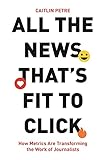All the news that's fit to click how metrics are transforming the work of journalists
Material type: TextPublication details: Princeton University Press 2020Description: 1 online resourceISBN:
TextPublication details: Princeton University Press 2020Description: 1 online resourceISBN: - 9780691228754
- 070.430285 PE-A
- PN4784.W43
- SOC052000 | COM021030
 Electronic-Books
Electronic-Books
| Item type | Home library | Collection | Shelving location | Call number | Materials specified | Status | Date due | Barcode | |
|---|---|---|---|---|---|---|---|---|---|
 Electronic-Books
Electronic-Books
|
OPJGU Sonepat- Campus | E-Books Perpetual | Main Library | 070.430285 PE-A (Browse shelf(Opens below)) | Available (Restricted Access) | 701717 |
Includes bibliographical references and index.
Digital journalism: putting the case in context -- Part I. Experiencing metrics -- The traffic game -- Enchanted metrics -- Part II. Making sense of metrics -- The interpretive ambiguity of metrics -- Clean and dirty data -- Part III. The struggle to monopolize interpretive labor -- The autonomy paradox -- Conclusion -- Appendix A: methods -- Appendix B: A guide to the Chartbeat Publishing Dashboard.
"Over the past fifteen years, journalism has experienced a rapid proliferation of data about online reader behavior in the form of web metrics. These newsroom metrics influence which stories are written, how news is promoted, and which journalists get hired and fired. Some argue that metrics help journalists better serve their audiences. Others worry that metrics are the contemporary equivalent of a stopwatch-wielding factory manager. In Desperate Measures, Caitlin Petre offers a rare behind-the-scenes look at how metrics are reshaping the work of journalism. Over a period of four years, Petre conducted a mix of in-depth interviews and ethnographic observation at three sites. The book first shows how metrics tools are designed and marketed, via Petre's research at the prominent news analytics company Chartbeat. Petre then follows Chartbeat's tool into the newsrooms of two of the company's highest-profile clients: Gawker Media and The New York Times. She finds that newsroom metrics are a powerful form of managerial surveillance and discipline. However, unlike the manager's stopwatch that preceded them, digital metrics are designed to gain the trust of wary journalists by providing a habit-forming user experience that mimics key features of addictive games. She details how the ambiguous nature of the data lead journalists to draw seemingly arbitrary boundaries around uses of audience metrics that are either legitimate or illegitimate. And she examines how metrics intersect with existing newsroom hierarchies. As performance analytics spread to virtually every professional field, Petre's findings speak to the future of expertise and labor relations in contexts far beyond journalism"--
There are no comments on this title.

